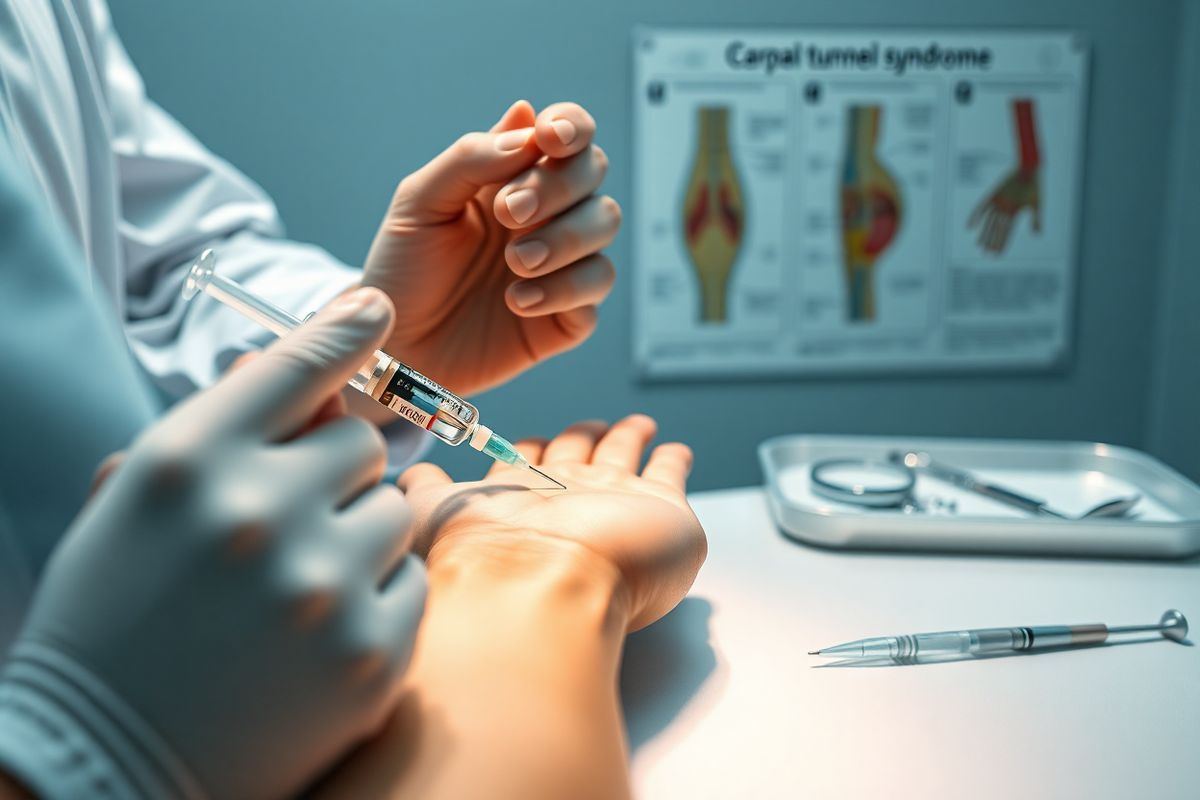Table of Contents
What Are Corticosteroid Injections and How Do They Work for Carpal Tunnel Syndrome?

Corticosteroids are powerful anti-inflammatory medications that can be administered through injections directly into the affected area, such as the carpal tunnel. This form of treatment aims to reduce inflammation around the median nerve, alleviating pain and discomfort. When injected, corticosteroids work by decreasing the immune response in the localized area, thereby reducing swelling and irritation of the nerves and surrounding tissues.
Studies indicate that corticosteroid injections can provide significant relief for patients suffering from CTS. The injections typically contain a corticosteroid medication, such as triamcinolone or methylprednisolone, combined with a local anesthetic like lidocaine to minimize discomfort during the procedure (Mayo Clinic, 2024; Better Health, 2024).
The effectiveness of corticosteroid injections varies among individuals. While some may experience immediate relief within hours, for others it might take several days to notice improvements. The duration of symptom relief can last from a few weeks to several months, depending on the severity of the condition and individual patient factors.
Evaluating the Success Rates of Corticosteroid Injections in Treating Carpal Tunnel Syndrome

Research shows that corticosteroid injections are generally effective in managing the symptoms of CTS. A systematic review indicated that 70-80% of patients experience relief from symptoms following an injection (Mayo Clinic, 2024). However, the effectiveness can be influenced by factors such as the duration and severity of the symptoms, the presence of underlying conditions like diabetes, and individual anatomical differences (Rodríguez et al., 2024).
TablSuccess Rates of Corticosteroid Injections for Carpal Tunnel Syndrome
| Study | Success Rate (%) | Duration of Relief |
|---|---|---|
| Mayo Clinic (2024) | 70-80 | Weeks to Months |
| Better Health (2024) | 75 | 3-6 Months |
| Rodríguez et al. (2024) | 80 | 1-3 Months |
Potential Side Effects of Corticosteroid Injections: What You Need to Know
While corticosteroid injections can provide significant relief, they are not without potential side effects. Common side effects include:
- Pain at the Injection Site: Some patients may experience localized pain or discomfort after the injection, which usually subsides within a few days.
- Flushing: A temporary feeling of warmth or flushing, especially in the face and chest, may occur.
- Increased Blood Sugar Levels: For individuals with diabetes, corticosteroid injections can cause a temporary spike in blood sugar levels (Mayo Clinic, 2024).
- Nerve Damage: Although rare, there is a risk of nerve damage if the injection is not administered correctly, which can lead to further complications.
- Tendon Weakening: Repeated use of corticosteroid injections can lead to tendon weakening or rupture, particularly around the wrist (Mayo Clinic, 2024).
Serious complications are uncommon but may include allergic reactions, bleeding, and infections. It is crucial for patients to discuss their medical history and any medications they are currently taking with their healthcare provider before proceeding with corticosteroid injections.
Preparing for Your Corticosteroid Injection: Tips for a Smooth Experience
Preparation for a corticosteroid injection involves several steps to ensure a smooth and effective procedure. Here are some tips:
- Consult with Your Healthcare Provider: Discuss any concerns or previous medical conditions that may affect the injection, such as diabetes, allergies, or blood thinning medications.
- Avoid Blood Thinners: If you are taking blood thinners, your healthcare provider may advise you to stop them for a short period before the injection to minimize bleeding risks (NHS, 2023).
- Wear Comfortable Clothing: Choose loose-fitting clothing to allow easy access to the injection site.
- Plan for Aftercare: Arrange for someone to drive you home if you will be receiving sedation, even mild sedation, during the procedure.
- Relax: Try to stay calm, as anxiety can increase discomfort during the injection.
Post-Injection Care: Maximizing Benefits and Minimizing Risks
After receiving a corticosteroid injection, following specific aftercare instructions can enhance the treatment’s effectiveness and minimize risks:
- Rest the Affected Area: Avoid strenuous activities for at least 24 hours post-injection to allow the medication to take effect effectively.
- Ice Application: Apply ice wrapped in a cloth to the injection site for 10-15 minutes every couple of hours to reduce swelling and discomfort.
- Monitor Symptoms: Keep track of your symptoms, noting any changes or side effects, and report them to your healthcare provider.
- Gradual Return to Activity: Gradually reintroduce activities to the affected hand, avoiding excessive force or repetitive motions for the first few days.
- Follow-Up Appointments: Schedule follow-up visits to assess the effectiveness of the injection and discuss any further treatments if necessary.
FAQ Section
How long does it take for corticosteroid injections to work for CTS?
Some patients may experience relief within hours, while others may take a few days to notice improvements. The full effect may take up to a week.
How often can I receive corticosteroid injections?
It is generally recommended to limit corticosteroid injections to three to four times a year to minimize the risk of side effects (NHS, 2023).
Are corticosteroid injections a permanent solution for CTS?
Corticosteroid injections are not a permanent fix; they provide temporary relief. Long-term solutions may include physical therapy or surgical options for chronic cases.
What should I do if I don’t feel relief after the injection?
If you do not experience any relief within a week or if your symptoms worsen, consult your healthcare provider to explore other treatment options.
References
- Better Health. (2024). Carpal tunnel syndrome. Retrieved from https://www.betterhealth.vic.gov.au/health/conditionsandtreatments/carpal-tunnel-syndrome
- Mayo Clinic. (2024). Carpal tunnel syndrome - Symptoms and causes. Retrieved from https://www.mayoclinic.org/diseases-conditions/carpal-tunnel-syndrome/symptoms-causes/syc-20355603
- NHS. (2023). Steroid injections. Retrieved from https://www.nhs.uk/conditions/steroid-injections/
- Rodríguez, P., Casado, A., Ciurana, N., García, M., Pastor, F., & Potau, J. M. (2024). Quantitative Analysis of the Carpal Tunnel and Its Inner Structures in Primates. American Journal of Primatology. Retrieved from https://pubmed.ncbi.nlm.nih.gov/11650946/









